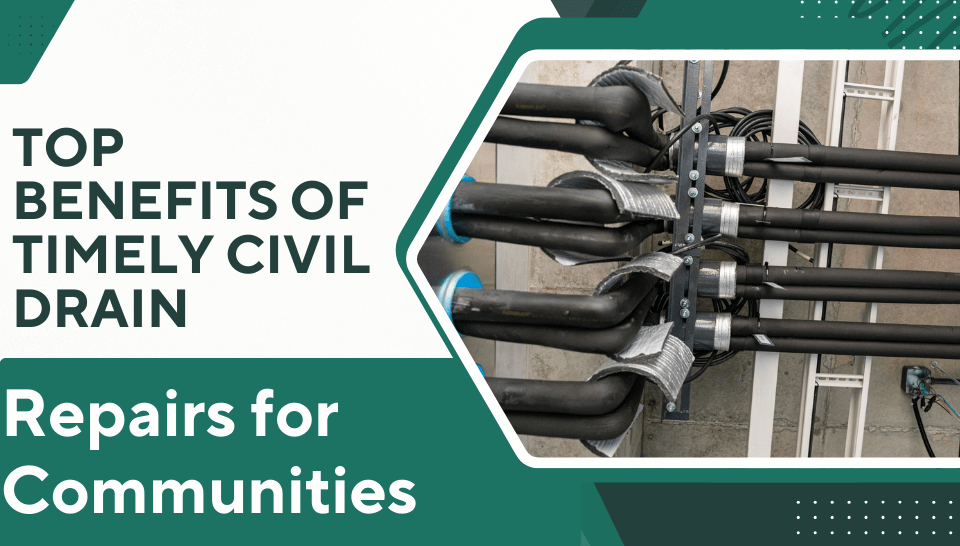
Every community needs a good drainage system. It keeps roads safe, protects homes, and prevents flooding in public areas. When drains become damaged or blocked, the results are immediate and costly. Roads can flood, public health risks rise, and infrastructure suffers long-term damage. Knowing the importance of civil drain repairs is key to safe, lasting communities.
Civil Drainage System Explained
A civil drainage system is more than just pipes underground. It’s a system of drains, culverts, and channels. They collaborate to manage stormwater and wastewater with optimal effectiveness. These systems move water away from streets, parks, and properties. This protects the environment and the built infrastructure.
When any part of this system fails, water builds up in areas not designed to hold it. This damages roads, pavements, and nearby buildings. It also creates hazards for pedestrians and drivers.
Why Timely Drain Repairs Matter
Drainage problems rarely solve themselves. A small crack or blockage may not seem urgent, but it can quickly turn into a large-scale issue. Timely repairs ensure that minor faults do not escalate into major infrastructure failures.
Communities that check drains regularly face fewer problems. They also spend less on repairs and live in safer conditions.
Benefits of Civil Drainage Maintenance
Acting early costs less than fixing emergencies caused by flooding or collapse.
Routine maintenance and timely repairs deliver several key advantages for communities:
- Reduces flooding risks: A well-maintained system channels stormwater away, even during heavy rainfall.
- Prevents road damage: Roads last longer when drains move water away. This stops cracks and potholes.
- Protects public spaces: Parks, playgrounds, and other areas stay safe when drains work well.
- Supports safety: Clear drains cut the risk of accidents from standing water and slippery ground.
- Saves long-term costs: Small-scale maintenance prevents large, expensive reconstruction projects.
Impact of Neglected Drain Repairs
Ignoring drainage problems has far-reaching consequences. Communities that delay repairs often face:
- Increased flooding incidents disrupt traffic and damage property.
- Health concerns due to stagnant water breeding pests and spreading bacteria.
- Infrastructure damage as water weakens foundations, roads, and pavements.
- Higher costs because delayed repairs require more labor and resources later.
In one area, a neglected roadside drain caused repeated flooding in a neighborhood. Repairing the first cracks on time would have cost far less than fixing the system later.
Role of Drain Repair in Community Health
Beyond infrastructure, drainage systems directly influence public health. Stagnant or overflowing drains create an environment for mosquitoes, rodents, and harmful bacteria. These health hazards affect families, schools, and businesses alike.
Keeping drains in good condition stops the spread of waterborne diseases. It also improves living standards in the community. The role of drain repair in community health cannot be ignored. It is about well-being as much as it is about infrastructure.
Case Example: Preventing Urban Flooding
A town centre once experienced repeated flooding during heavy spring rains. Shops lost business, and roads became impassable. After an inspection, engineers found that the main drainage line was partially collapsed. Once civil drain repairs were carried out, the flooding problem disappeared. Businesses stayed open, and the local economy benefited.
This example shows that the benefits of civil drainage maintenance go beyond infrastructure. It also protects jobs and supports local businesses.
Practical Steps Communities Can Take
Communities can reduce drainage problems by taking proactive measures:
- Schedule regular inspections before and after rainy seasons.
- Report blocked or damaged drains to local authorities immediately.
- Encourage residents to keep litter and debris out of drainage grates.
- Work with professionals for timely repairs instead of temporary fixes.
These steps ensure that drains remain functional and the community stays protected year-round.
Conclusion: Building Stronger Communities with Reliable Drain Repairs
Civil drainage systems are the backbone of safe and resilient communities. Councils and residents can safeguard roads, homes, and public health. They should understand how important civil drain repairs are. Early action cuts repair costs. It keeps daily life running smoothly. It also improves cleanliness and safety in the community.
👉 At C4Plus Drainage, we specialise in keeping community drainage systems in top condition. Our team manages routine maintenance and urgent repairs. We provide solutions that protect your community from flooding and damage. Contact us today to schedule an inspection and keep your drainage system working at its best.
FAQs
Q1: How do drain repairs prevent flooding?
Drain repairs clear blockages, fix cracks, and restore the system. This allows water to flow away as it should. When drains work well, rainwater flows into the underground system. This prevents pooling on roads and in public areas.
Q2: What is the main purpose of a drainage system?
The main purpose of a drainage system is to manage water safely. It carries extra rain and wastewater away from homes, roads, and public areas. This reduces flooding, protects health, and keeps infrastructure safe.


